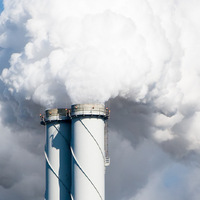Flue Gas Cleaning in Coal-Fired Power Plants
Application

Flue Gas Cleaning in Coal-Fired Power Plants by using K-System and SC-System Interface Modules.
Flue gas cleaning removes powdered and gaseous residues left by the combustion process from the flue gas, and entails dust removal, desulfurization, and denitrification. To extract sulfur from the flue gas, the gas is sprayed with limewater, which reacts chemically with the components that contain sulfur. The flue gas is treated with ammonia water to remove nitrogen. Dust is removed via baghouse and electric filters that are cleaned mechanically; these filters are not part of the automation process.
Goal
When monitoring the lime scrubbing process, the rotational speed and delivery rate of the limewater pump are checked to prevent the chemical reaction from being interrupted, which would result in an excessive discharge of sulfur compounds. The same thing would happen if the fill level of the limewater reservoir was too low. The trip values for the reservoir are therefore monitored. When ammonia water – whose volume depends on the nitrogen oxides, temperature, and volume flow of the flue gas – is injected to remove nitrogen from the flue gas, relevant measured values are monitored to detect pump failure at an early stage, or to prevent dry running.
Benefits
K-System interface modules, featuring galvanic isolation and functional safety up to SIL3, transmit signals between individual system components and the control room without any interference. Signal conditioners without explosion protection certification are generally used in flue gas cleaning. With the K-System, any requirements that arise can be handled using modules from one portfolio. The SC-System, which features modules just 6 mm wide mounted on a DIN mounting rail, is compact and efficiently produces galvanic isolation between the field and control side, making it suitable to transmit analog values.
Solution
Using frequency converters to monitor motor speed is a solution that is especially beneficial for pumps for injecting limewater and ammonia water. This enables risks caused by deficient flue gas desulfurization and denitrification to be detected at an early stage. In addition to frequency monitoring, the signal converters provide other services, including slip and rotation direction detection. Transmitter power supplies and fill-level transmitters are used to monitor delivery rates and fill level, and to achieve a continuous supply of both media. As the dosing of ammonia water depends on a range of factors, including the temperature of the flue gas, the relevant trip values are determined via temperature converters.
At a Glance
- Frequency converters are used to monitor the rotational speed and delivery rates of pumps to prevent an incorrect injection of ammonia water, and issues relating to limewater.
- Conductive switch amplifiers monitor the fill level of the limewater reservoir.
- Safe and reliable signal conversion, and amplification of the flue gas measurement data, such as temperature, volume flow, and nitrogen oxide concentration








 +82 2 34819494
+82 2 34819494